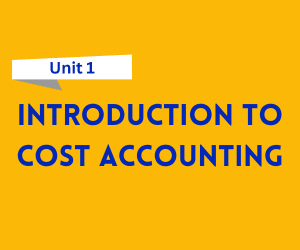Cost accounting is a vital part of management accounting that helps businesses track, control, and reduce costs to improve profitability. This unit introduces the meaning, objectives, and importance of cost accounting, differences from financial accounting, cost classification methods, and preparation of a cost sheet. It also explains the essentials of installing an effective costing system and the role of cost audit and cost control in business decision-making.

Download Unit 1 – Promotion Mix and Digital Marketing Notes
Get simplified revision notes for this unit:
⬇️
Download Unit 1 Notes PDF
Meaning, Objectives, and Importance of Cost Accounting
Cost accounting refers to the process of recording, classifying, analyzing, and controlling the costs associated with production or services. Its primary objective is to determine the cost per unit, identify cost-saving opportunities, and assist management in decision-making. Unlike financial accounting, which focuses on overall financial performance, cost accounting provides detailed cost data for internal use.
Importance:
Helps in cost control and cost reduction
Aids in pricing decisions and profit planning
Assists in budgeting and variance analysis
Supports management decisions like make-or-buy, product mix, and process improvement
Differences Between Cost Accounting and Financial Accounting
While both are branches of accounting, they serve different purposes:
| Basis | Cost Accounting | Financial Accounting |
|---|---|---|
| Objective | Control and reduction of costs | Recording financial transactions |
| Users | Internal management | External stakeholders |
| Period | Continuous and detailed | Prepared at year-end |
| Nature of data | Future-oriented with estimates | Historical and factual |
Understanding these differences is crucial for applying the right approach in different business scenarios.
Classification of Costs
Cost classification helps in analyzing and controlling expenses. Major classifications include:
By Nature:
Direct Costs – Directly traceable to a product (e.g., raw materials, direct labor).
Indirect Costs – Not directly attributable (e.g., factory rent, supervision).
By Behavior:
Fixed Costs – Remain constant irrespective of output (e.g., rent, salaries).
Variable Costs – Change with production levels (e.g., raw materials, power).
By Control:
Controllable Costs – Can be influenced by management (e.g., overtime wages).
Uncontrollable Costs – Beyond managerial control (e.g., taxes, depreciation).
This classification is essential for cost analysis and decision-making.
Preparation of Cost Sheet – Format and Components
A cost sheet is a statement showing the total cost of production and cost per unit in a systematic manner. It includes:
Prime Cost = Direct Materials + Direct Labor + Direct Expenses
Factory/Works Cost = Prime Cost + Factory Overheads
Cost of Production = Works Cost + Office & Admin Overheads
Cost of Sales = Cost of Production + Selling & Distribution Overheads
Cost sheets help management analyze costs at each stage and set appropriate selling prices.
Cost Concepts Used in Decision-Making
Some important cost concepts include:
Marginal Cost – Additional cost for producing one more unit
Opportunity Cost – Value of the next best alternative foregone
Standard Cost – Predetermined cost for comparison and control
Relevant Cost – Costs that affect a particular decision
These concepts assist managers in pricing, make-or-buy, and cost optimization decisions.
Installation of Costing System
To implement an effective costing system, businesses must ensure:
Essentials of a Good Costing System:
Simplicity and ease of understanding
Flexibility to adapt to changing conditions
Accuracy in recording and reporting costs
Coordination between departments for smooth functioning
Difficulties in Installation:
Resistance from staff
High initial cost of implementation
Lack of technical expertise
Solutions:
Proper training of staff
Gradual implementation to minimize disruptions
Clear communication of benefits to employees
Cost Audit and Cost Control
Cost Audit – Verification of cost records to ensure accuracy and compliance with cost accounting standards. It helps detect fraud and inefficiencies.
Cost Control – Continuous monitoring of costs to ensure they remain within predetermined limits through budgeting, standard costing, and variance analysis.
